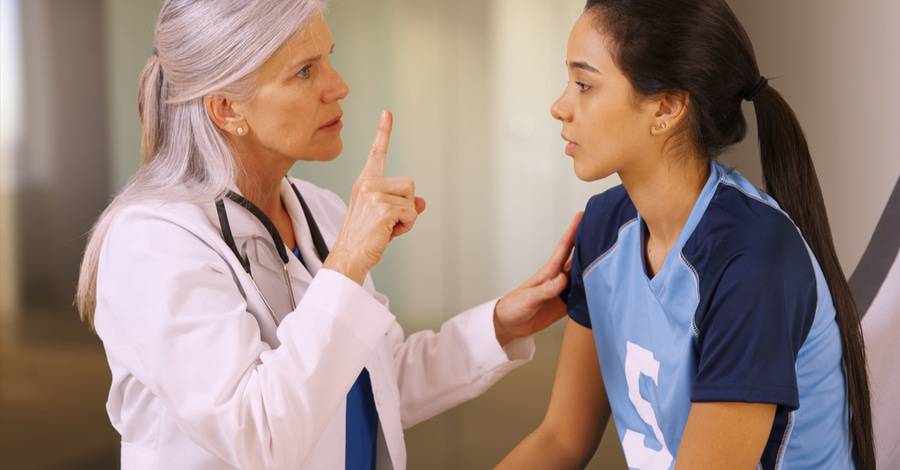Preventing Sports-Related Concussions in Youth Sports
Don’t ignore the signs and symptoms of this type of brain injury

Don’t ignore the signs and symptoms of this type of brain injury
When it comes to youth sports, safety discussions should always include lessons about concussion risks and prevention.
Parents, coaches and players should all be familiar with concussion prevention strategies – including proper training and protective equipment – and know what to do in case of a sports-related concussion during practice or a game.
“You can never be too careful when it comes to a head injury, especially with children and adolescents whose brains are still developing,” says Shaun Berger, MD, a pediatrician at Scripps Clinic Rancho San Diego.
“If a player suffers a head injury, the player should be removed from the game immediately for proper evaluation.
“If you suspect a concussion, call a physician right away or go to a hospital emergency room for immediate evaluation.
“They should not be allowed to return to play on the same day of the injury and at all without clearance from a medical provider with experience in concussion management,” Dr. Berger, who is also board certified in sports medicine, says.
What is a concussion?
A concussion is a type of traumatic brain injury that is usually caused by a bump, jolt or blow to the head, or hit to the body that causes the head and brain to move rapidly back and forth. This sudden movement can cause the brain to bounce around or twist in the skull. This injury can cause multiple symptoms, including headache and confusion.
While a concussion is usually not life-threatening, there are really no minor concussions.
“Every concussion is serious with potential complications and should be evaluated by a trained medical professional,” Dr. Berger says. “Proper care and management are essential to ensure optimal recovery.”
Sports concussions
Up to 3.8 million concussions occur annually during sports and recreational activities at all ages in the United States, according to studies. Many occur in contact sports.
Football is the main sport causing concussions in high school boys, and soccer is the main sport causing concussions in high school girls.
The HEADS UP Concussion in Youth Sports initiative provides information to coaches, parents and athletes involved in youth sports on preventing, recognizing and responding to a concussion. Concussion prevention efforts in youth sports have focused on protective equipment, education programs and rule changes.
Recognizing concussions
Failure to recognize a concussion and seek immediate medical care can lead to long-term health problems, brain damage, even death.
Young athletes should be taught to always inform their coach or parent if they have hit their head or have a symptom of a head injury.
Parents and coaches should learn to recognize the signs of a concussion. Many concussions are never reported for a variety of reasons. Sometimes a player is embarrassed to come out of a game or wants to tough it out despite an injury.
“With head injuries, playing through the pain is a dangerous idea,” Dr. Berger says. “Concussion symptoms should be evaluated immediately by an athletic trainer or physician.”
Signs of concussion as observed by parents or guardians include:
- Confusion, appearing dazed or stunned
- Forgetting an instruction or assignment
- Repeating questions
- Inability to recall events prior to or before the hit, bump or fall
- Moving clumsily
- Answering questions slowly
- Losing consciousness, even briefly
- Showing mood, behavior or personality changes
Symptoms of concussion as reported by an athlete include:
- Headache or pressure in head
- Slurred speech
- Repeated nausea or vomiting
- Confusion
- Bothered by light and noise
- Balance problems or dizziness
- Feeling sluggish, hazy, foggy or groggy
Concussion danger signs
In rare cases, a dangerous collection of blood may form on the brain after a head injury. Call 911 or take your child or teen to the emergency room if you see any of these signs:
- One pupil larger than the other
- Drowsiness or unable to wake up
- A headache that gets worse and does not go away
- Slurred speech, weakness, numbness
- Repeated vomiting or nausea, convulsions or seizure
- Increased confusion, restlessness or agitation
- Loss of consciousness
Treatments for concussions
Every concussion requires individualized care and management. What’s right for one person may not be right for another. All factors must be considered, including general health, medical history, age, prior injuries and post-concussion symptoms.
Symptoms of concussion usually resolve in four weeks in most patients. Activities that involve a lot of concentration or physical exertion may cause a patient’s symptoms to recur or worsen and should be carefully managed during the healing process. For headaches, Tylenol can be taken.
When to return to play?
Return to play decisions should be done with health and safety as the top priorities. Sometimes a second concussion may occur before the first one has fully healed. These “second impact” concussions can cause additional trauma to the brain, including brain swelling and widespread damage. They carry a higher risk of long-term cognitive dysfunction and may even be fatal.
Dr. Berger states, “I like to consider a concussion to be a ‘brain sprain’” and not to return to play too soon and risk re-injury.”
The American Academy of Pediatrics provides guidance on when an athlete can return to play after a concussion.